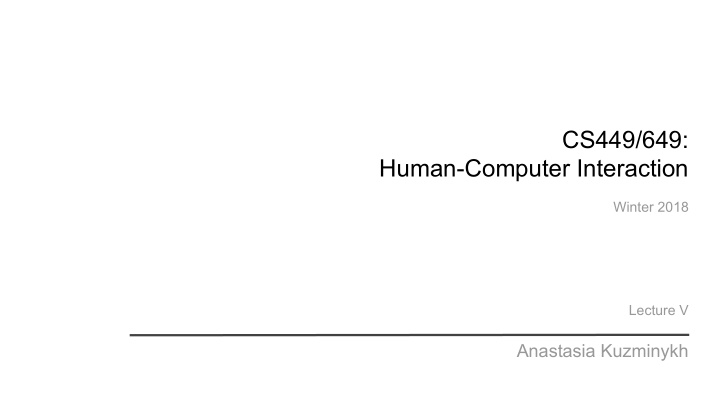



CS449/649: Human-Computer Interaction Winter 2018 Lecture V Anastasia Kuzminykh
Understand Your Users: Exploratory Studies Exploratory Study Contextual Cognitive Motivational system knowledge & beliefs (Mental) model - A cognitive representation - Goals and tasks (“need”) (understanding) of how - Desirability (“want”) something works / organised - Emotional charge (“fears”, - Based on previous experience & frustration, pleasure, etc.) beliefs; defines reasoning
Translating Needs Into Functionalities Make data Identify right time Turn problems actionable and place into tasks Adjust personas Thinking Physical model Affinity diagrams Memory Sequence model Attention Breakdowns Flow model Motivations Cultural model Habituation Artifact models
Translating Needs Into Functionalities Make data Identify right time Turn problems actionable and place into tasks Adjust personas Thinking Physical model Affinity diagrams Memory Sequence model Attention Breakdowns Flow model Motivations Cultural model Habituation Artifact models
Translating Needs Into Functionalities Make data actionable Make them more colorful and detailed based on the generalized characteristics of your participants you did not account Adjust personas for previously Affinity diagrams Breakdowns (most likely there are several) Cultural model Artifact models
Translating Needs Into Functionalities Make data A sense-making tool for qualitative data actionable Notes on Review Sorting & cards the cards grouping Adjust personas Affinity diagrams Sub - Themes in groups Data Breakdowns Cultural model Artifact models
Translating Needs Into Functionalities Where and when things go wrong Make data actionable in individuals work practice Points in time or space when individuals have a problem Adjust personas accomplishing the task that should Affinity diagrams otherwise be easy, given the tools that they are using Breakdowns Cultural model Unpacking the tacit dimension for Artifact models possible design solutions
Translating Needs Into Functionalities External influences - because: Make data “ Work takes place in a culture, which actionable defines expectations, desires, policies, values, and the whole approach people take to work ” Beyer, Hugh, and Karen Holtzblatt. Adjust personas Contextual design: defining customer-centered systems . Affinity diagrams Includes: ● Influencers (represented as bubbles) Breakdowns ● Extent of influence (overlap of bubbles) Cultural model ● Influences (as arrows - mind direction) Artifact models ● Breakdowns
Cultural Model Beyer, Hugh, and Karen Holtzblatt. Contextual design .
Cultural Model Beyer, Hugh, and Karen Holtzblatt. Contextual design: defining customer-centered systems .
Cultural Model (Consolidated) Beyer, Hugh, and Karen Holtzblatt. Contextual design .
Translating Needs Into Functionalities Make data actionable Adjust personas Affinity diagrams Breakdowns Cultural model Artifact models Beyer, Hugh, and Karen Holtzblatt. Contextual design .
Translating Needs Into Functionalities Make data Physical objects that support the work actionable (created and/or used in the process) - because you want to know what objects people need and interact with Sketch or photo Adjust personas Affinity diagrams Complete with comments and notes on: Breakdowns ● Structure Cultural model ● Related purpose and tasks Artifact models ● Functionality
Artifact Model Beyer, Hugh, and Karen Holtzblatt. Contextual design: defining customer-centered systems .
Artifact Model Beyer, Hugh, and Karen Holtzblatt. Contextual design .
Artifact Model (Consolidated) Beyer, Hugh, and Karen Holtzblatt. Contextual design .
Translating Needs Into Functionalities Make data actionable Adjust personas Affinity diagrams Breakdowns Cultural model Artifact models Beyer, Hugh, and Karen Holtzblatt. Contextual design: defining customer-centered systems .
Translating Needs Into Functionalities Make data Identify right time Turn problems actionable and place into tasks Adjust personas Thinking Physical model Affinity diagrams Memory Sequence model Attention Breakdowns Flow model Motivations Cultural model Habituation Artifact models
Translating Needs Into Functionalities Physical work environment (plan) - Identify right time because you want to know how people adapt their and place environment to accomplish work Includes: ● Structures that limit and define space Physical model ● Walls, desks, file cabinets, etc. Sequence model ● Hardware, software, communication tools ● Artifacts and their location in relation to Flow model each other Complete with comments and notes
Physical Model
Physical Model Beyer, Hugh, and Karen Holtzblatt. Contextual design .
Physical Model (Consolidated) Beyer, Hugh, and Karen Holtzblatt. Contextual design .
Translating Needs Into Functionalities Identify right time and place Physical model Sequence model Flow model
Translating Needs Into Functionalities Sequence of work steps and the Identify right time intention behind steps - because you want and place to know how work is organized in stages Includes: ● Intent behind step Physical model ● Triggers, that initiate sequence ● Steps, at a high level of details (actions, not Sequence model movements) Flow model ● Loops and branches showing order and iteration ● Breakdowns (where things go wrong)
Sequence Model
Sequence Model Beyer, Hugh, and Karen Holtzblatt. Contextual design .
Translating Needs Into Functionalities Identify right time and place Physical model Sequence model Flow model
Translating Needs Into Functionalities Identify right time Directions of communication and and place coordination Defines how work is broken up across people and how people coordinate Includes: Physical model ● Interviewee (in the middle - circle) Sequence model ● Other groups/people (circles) ● Physical/virtual places (usually rectangles) Flow model ● Artifacts as they pass between people ● Breakdowns (where things go wrong)
Flow Model Beyer, Hugh, and Karen Holtzblatt. Contextual design .
Flow Model
Translating Needs Into Functionalities Identify right time and place Physical model Sequence model Flow model
Translating Needs Into Functionalities: Preparation Personas Affinity Diagram Physical Model Cultural Model (Physical work environment) (External influences) Work Models Artifact Model Sequence Model (Physical objects) (Work steps) Flow Model (communication and coordination)
Recommend
More recommend